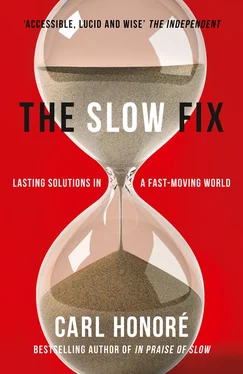1 ...7 8 9 11 12 13 ...16 Yet the change is paying off. In the first three years of the new regime, 210 near misses or errors were reported at RAF Coningsby. Of these, 73 triggered an investigation. In each one, steps were taken to make sure the mistake never happened again. ‘Given that we never reported near misses before, that’s a quantum shift, a big leap of faith in people,’ says Brailsford. ‘Instead of putting a plaster over problems, we’re now going deeper and dealing with them at their root. We’re nipping problems in the bud by stopping them before they even happen.’ Other air forces, from Israel to Australia, have taken notice.
Adding the mea culpa to your problem-solving toolbox pays off beyond the military. Take ExxonMobil. After the epic Exxon Valdez oil spill off the coast of Alaska in 1989, the company set out to catch and investigate every screw-up, however small. It walked away from a large drilling project in the Gulf of Mexico because, unlike BP, it decided drilling there was too risky. Safety is now such a part of the corporate DNA that every buffet laid out for company events comes with signs warning not to consume the food after two hours. In its cafeterias, kitchen staff monitor the temperature of their salad dressings.
Every time an error occurs at an ExxonMobil facility, the first instinct of the company is to learn from it, rather than punish those involved. Staff talk about the ‘gift’ of the near miss. Glenn Murray, an employee for nearly three decades, was part of the Valdez clean-up. Today, as head of safety at the company, he believes no blunder is too small to ignore. ‘Every near miss,’ he says, ‘has something to teach us if we just take the time to investigate it.’
Like the RAF and Toyota, ExxonMobil encourages even the most junior employee to speak up when something goes wrong. Not long ago a young engineer new to the company was uneasy about a drilling project in West Africa – so he temporarily closed it down. ‘He shut down a multi-million dollar project because he felt there were potential problems and we needed to pause and think it all through, and management backed him,’ says Murray. ‘We even had him stand up at an event and named him Employee of the Quarter.’ By every yardstick, Exxon now has an enviable safety record in the oil industry.
Mistakes can also be a gift when dealing with consumers. Four out of every five products launched perish within the first year, and the best companies learn from their flops. The Newton MessagePad, the Pippin and the Macintosh Portable all bombed for Apple yet helped pave the way for winners like the iPad.
Even in the cut-throat world of brand management, where the slightest misstep can send customers stampeding for the exit and hobble the mightiest firm, owning up to mistakes can deliver a competitive edge. In 2009, with sales tanking in the United States, Domino’s Pizza invited customers to deliver their verdict on its food. The feedback was stinging. ‘Worst excuse for a pizza I’ve ever tasted,’ said one member of the public. ‘Totally devoid of flavour,’ said another. Many customers compared the company’s pizza crust to cardboard.
Rather than sulk, or sit on the results, Domino’s issued a full-blown mea culpa . In documentary-style television commercials, Patrick Doyle, the company’s CEO, admitted the chain had lost its way in the kitchen and promised to deliver better pizzas in the future. Domino’s then went back to the drawing board, giving its pies a complete makeover with new dough, sauce and cheese.
Its Pizza Turnaround campaign worked a treat. Year-on-year sales surged 14.3 per cent, the biggest jump in the history of the fast-food industry. Two years after the apology the company’s stock price was up 233 per cent. Of course, the new pizza recipes helped, but the starting-point was Domino’s doing what RAF air crews and Exxon employees are now expected to do as a matter of course: acknowledging the error of its ways. This allowed the firm to learn exactly where it was going wrong so it could fix it. It also cleared the air. These days, so many companies trumpet ‘new and improved’ products that the net effect is a whirlwind of white noise that leaves consumers cold. The very act of owning up to its mistakes allowed Domino’s to cut through the din and reboot its relationship with customers.
PR experts agree that the best way for a company to handle a mistake is to apologise and explain what it will do to put things right. This accords with my own experience. The other day a payment into my bank account went astray. After 20 minutes of evasion from the call centre, my voice began to rise as my blood reached boiling point. And then a manager came on the line and said: ‘Mr Honoré, I’m very sorry. We made a mistake with this payment.’ As she explained how the money would be retrieved, my fury drained away and we ended up bantering about the weather and our summer holidays.
Public apologies can have a similarly soothing effect. When a customer filmed a FedEx driver tossing a package containing a computer monitor over a six-foot fence in the run-up to Christmas 2011, the video went viral and threatened to annihilate sales during the busiest time of year. Rather than stonewall, though, the company apologised right away. In a blog post entitled ‘Absolutely, Positively Unacceptable’, FedEx’s senior vice-president for US operations announced he was ‘upset, embarrassed, and very sorry’ for the episode. The company also gave the customer a new monitor and disciplined the driver. As a result, FedEx weathered the storm.
Even when we squander other people’s money, owning up in order to learn from the error is often the best policy. In 2011, Engineers Without Borders (EWB) Canada set up a website called AdmittingFailure.com , where aid workers can post their mistakes as cautionary tales. ‘Opening up like that is completely the opposite of the norm in the sector, so it was a huge risk,’ says Ashley Good, Venture Leader at EWB. But it paid off. No longer afraid of being pilloried for messing up, EWB staff became more willing to take the sort of risks that are often the stepping stone to creative breakthroughs. ‘People now feel they have the freedom to experiment, push themselves, take chances because they know they won’t be blamed if they don’t get it right on the first try,’ says Good. ‘And when you push boundaries like that, you get more creative solutions to problems.’ One example: after much trial and error, EWB has devised a system that improves water and sanitation services in Malawi by mobilising district governments, the private sector and communities all at the same time. Workers from across the development sector now post their own stories on AdmittingFailure.com . EWB’s donors love the new regime, too. Instead of dashing for the exit, they welcomed the eagerness to learn from mistakes. Says Good: ‘We’ve found that being open and honest actually builds a stronger bond and higher trust with our donors.’
The same holds true in personal relationships. A first step towards rebuilding bridges after falling out with a partner, friend, parent or child is for all parties to take their share of the blame. Admitting mistakes can ease the guilt and shame gnawing at the wrongdoer and help the victim overcome the anger that often stands in the way of forgiveness. Marianne Bertrand sees the magic of the mea culpa every week in her job as a family therapist in Paris. ‘Many people sit in my office and cannot even begin to address their problems because they are stuck in the rage and resentment for what went wrong,’ she says. ‘But when they finally accept and apologise sincerely for their mistakes, and hear the other person doing the same, you can really feel the atmosphere in the room change, the tension subside, and then we can start working on reconciliation.’
Читать дальше












